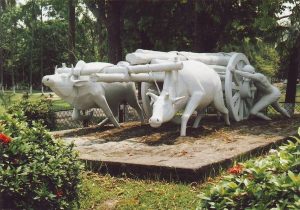Shilpacharya Zainul Abedin Sangrahashala: জয়নুল আবেদিন সংগ্রহশালা
Introduction
Nestled in the heart of Mymensingh, Bangladesh, the Shilpacharya Zainul Abedin Sangrahashala stands as a beacon of cultural heritage and artistic brilliance. This art gallery, named after the renowned Bangladeshi artist Zainul Abedin, serves not only as a repository of his works but also as a tribute to his immense contributions to the art world. Established to honor the legacy of the “Shilpacharya” or “Great Teacher of Art,” the museum offers a deep dive into the life and works of Zainul Abedin, whose artistic vision played a pivotal role in shaping modern Bangladeshi art.
The Life and Legacy of Zainul Abedin
Early Life and Education
Zainul Abedin was born on December 29, 1914, in Kishoreganj, Bengal Presidency, British India. From a young age, he displayed an extraordinary talent for drawing, which eventually led him to pursue formal education in art. He attended the Government School of Art in Kolkata (then Calcutta), where he honed his skills and developed a distinctive style that would later define his career.
Artistic Journey
Abedin’s journey as an artist was marked by a relentless pursuit of excellence and a deep connection to his roots. His early works were heavily influenced by the socio-political landscape of Bengal, reflecting the struggles and resilience of its people. One of his most notable early works, the “Famine Sketches” series, depicted the harrowing Bengal famine of 1943. These sketches not only brought him national acclaim but also established him as a socially conscious artist who used his talent to highlight pressing issues.
Contribution to Art and Culture
Zainul Abedin’s contributions to art extended beyond his own creations. He was instrumental in establishing the Art Institute in Dhaka in 1948, which later became the Faculty of Fine Arts at the University of Dhaka. His efforts in promoting art education and nurturing young talents earned him the title of “Shilpacharya.” Throughout his career, Abedin remained dedicated to fostering a vibrant art community in Bangladesh, advocating for the integration of traditional and modern art forms.
The Establishment of Shilpacharya Zainul Abedin Sangrahashala
Inception and Vision
The Shilpacharya Zainul Abedin Sangrahashala was established in 1975, a few years after Abedin’s death in 1976. The museum was envisioned as a space to preserve and showcase the artist’s extensive body of work, providing insight into his creative process and the socio-cultural context of his art. It was also intended to serve as a center for art education and appreciation, continuing Abedin’s legacy of nurturing artistic talent and cultural awareness.
Architectural Design
The design of the Shilpacharya Zainul Abedin Sangrahashala reflects a blend of traditional and modern architectural elements, much like Abedin’s own approach to art. The museum’s layout is spacious and inviting, with natural light illuminating the exhibits, creating an environment conducive to contemplation and appreciation of art. The galleries are organized thematically, allowing visitors to explore different phases of Abedin’s career and the various themes that he explored through his art.
Exhibits and Collections
Permanent Collection
The permanent collection of the Shilpacharya Zainul Abedin Sangrahashala comprises a vast array of Abedin’s works, including his iconic “Famine Sketches,” landscapes, portraits, and folk-themed paintings. Each piece in the collection is meticulously curated to highlight Abedin’s versatility and mastery of different mediums, from watercolor and oil to ink and pencil.
Temporary Exhibitions
In addition to its permanent collection, the museum hosts temporary exhibitions featuring works by contemporary Bangladeshi artists and international artists influenced by Abedin’s legacy. These exhibitions provide a platform for emerging talents and promote cross-cultural dialogue, staying true to Abedin’s vision of a dynamic and inclusive art community.

Special Collections
The museum also houses special collections that include Abedin’s personal artifacts, letters, and photographs. These collections offer a glimpse into the artist’s personal life, his inspirations, and his interactions with other prominent figures of his time. Through these exhibits, visitors gain a deeper understanding of the man behind the art and his enduring impact on Bangladeshi culture.
Educational and Outreach Programs
Art Workshops and Classes
In line with Zainul Abedin’s commitment to art education, the Shilpacharya Zainul Abedin Sangrahashala offers a range of workshops and classes for aspiring artists of all ages. These programs cover various aspects of art, from basic drawing and painting techniques to advanced studies in art history and criticism. The workshops are designed to be interactive and hands-on, encouraging participants to explore their creativity and develop their artistic skills.
Lectures and Seminars
The museum regularly hosts lectures and seminars featuring renowned art historians, critics, and practitioners. These events provide a platform for intellectual exchange and offer insights into contemporary art practices and trends. They also serve to highlight the ongoing relevance of Abedin’s work and its influence on modern art.
Community Engagement
Community engagement is a cornerstone of the museum’s outreach efforts. The Shilpacharya Zainul Abedin Sangrahashala organizes various community-based programs, including art competitions, public art projects, and cultural festivals. These initiatives aim to make art accessible to a wider audience and foster a deeper appreciation for Bangladeshi cultural heritage.
The Role of Shilpacharya Zainul Abedin Sangrahashala in Promoting Art
Preserving Cultural Heritage
The Shilpacharya Zainul Abedin Sangrahashala plays a crucial role in preserving Bangladesh’s cultural heritage. By safeguarding Abedin’s works and promoting his artistic legacy, the museum ensures that future generations can appreciate and learn from his contributions. The museum’s efforts in conservation and restoration are integral to maintaining the integrity of Abedin’s works and other valuable pieces in its collection.
Inspiring Future Generations
Through its extensive educational and outreach programs, the Shilpacharya Zainul Abedin Sangrahashala inspires future generations of artists and art enthusiasts. The museum provides a nurturing environment for young talents to explore their creativity and develop their skills. By showcasing the works of contemporary artists alongside Abedin’s masterpieces, the museum fosters a sense of continuity and encourages innovation in the arts.
Promoting International Art Exchange
The museum’s commitment to promoting international art exchange is evident in its collaborative projects with art institutions worldwide. These collaborations include joint exhibitions, artist residencies, and cultural exchange programs. By facilitating dialogue between artists from different cultural backgrounds, the Shilpacharya Zainul Abedin Sangrahashala contributes to a global understanding of art and culture.

Visitor Experience
Guided Tours
Visitors to the Shilpacharya Zainul Abedin Sangrahashala can enhance their experience through guided tours offered by the museum. Knowledgeable guides provide detailed insights into the exhibits, sharing stories about Abedin’s life and the historical context of his works. These tours offer a personalized and enriching experience, allowing visitors to connect more deeply with the art on display.
Interactive Displays
The museum incorporates interactive displays and multimedia installations to engage visitors and provide a more immersive experience. These displays include touchscreens with detailed information about the artworks, audio-visual presentations, and virtual tours. The use of technology enhances the visitor’s understanding and appreciation of the exhibits, making the museum visit both educational and enjoyable.
Museum Shop and Café
The museum shop offers a range of art-related merchandise, including prints, books, and souvenirs inspired by Zainul Abedin’s works. Visitors can take home a piece of the museum experience and support its ongoing programs. The café provides a relaxing space for visitors to unwind and reflect on their visit, offering a selection of refreshments and light meals.
Conclusion
The Shilpacharya Zainul Abedin Sangrahashala stands as a testament to the enduring legacy of Zainul Abedin and his profound impact on Bangladeshi art and culture. Through its extensive collection, educational programs, and community engagement initiatives, the museum continues to inspire and educate, fulfilling Abedin’s vision of a vibrant and inclusive art community. As a hub of cultural heritage and artistic excellence, the Shilpacharya Zainul Abedin Sangrahashala remains a vital institution in the cultural landscape of Bangladesh, celebrating the past while inspiring the future.
For further information, you can visit the official website of Shilpacharya Zainul Abedin Sangrahashala.







